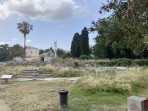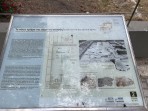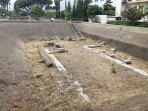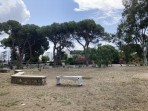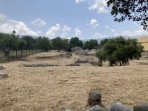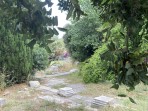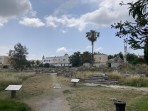Agora (archaeological site) - Kos island
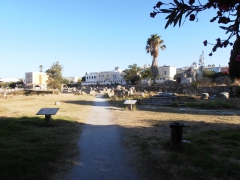
The Agora is located in the capital city of Kos and in the ancient period it was the main public space of the city, where political, commercial and social life was concentrated. Nowadays, the Agora is an important archaeological site that provides valuable information about the history and culture of ancient Greece thanks to discoveries and excavations from different historical periods.
History of Agora on the island of Kos
The Agora was founded between the 4th and 3rd centuries BC and originally served primarily as a marketplace. Thanks to its strategic location near the island's main port, it soon became an important centre for trade and exchange of goods of all kinds. The Agora marketplace flourished over time and developed architecturally and socially. It was an area where people met, discussed politics, traded various goods and participated in religious and social events.
The Agora in the capital city of Kos, like many other ancient Greek sites, has gone through several phases over the centuries, experiencing periods of development and reconstruction as well as times of decline and decay. For example, during the Roman period, new buildings were erected in the Agora reflecting Roman architectural influences (Roman baths, public buildings, etc.), while during the period of the Byzantine Empire, the Agora served mainly as a commercial and administrative centre. After the fall of the Byzantine Empire and in the medieval period, the Agora was less used and rather fell into disrepair. In the 14th century, material from the original settlement began to be taken for the construction of the new castle of the Knights of St. John (Neratzia Castle) and much of the stone remains were dismantled. Another blow to the historic marketplace was the great earthquake of 1933. On the other hand, the earthquake also uncovered foundations of an earlier date, sparking the interest of archaeologists to investigate further.
Archaeological site of Agora in the present
Archaeological excavations have revealed that there is much more to the Agora area than meets the eye. Remains of several temples, baths and other buildings dating back to the different time periods that the city of Kos has gone through have been discovered. For example, archaeologists have uncovered parts of the Temple of Heracles and one of the temples of the goddess Aphrodite. The early Christian Limenos Basilica from the 5th century has also been discovered and two ancient gates of the Agora have been preserved. Today, visitors can also admire rare architectural features such as Corinthian capitals, decorated columns or floor mosaics with natural and mythological motifs.
Other important finds include the remains of trade stalls and warehouses, which indicate the economic activity that took place at the Agora. These finds include grain storage vessels, wine and oil amphorae, and various types of tools and equipment. The foundations of public buildings such as the city council (bouleuterion), courthouses and other administrative buildings, which represented the centre of the city's political life, were also uncovered. Texts were even found, often containing decrees, laws, trade agreements and other important documents.
Excavations in the archaeological area of the Agora are still ongoing today, but the site is open and accessible to the public. We also recommend a visit to the Archaeological Museum, which is located in Platia Elefherias Square in Kos, and boasts a particularly beautiful mosaic dating from the 2nd to 3rd centuries.
More touristic destinations of Kos
Most favourite sights of Kos: Agora (archaeological site), Archaeological Museum (Kos Town), Asklepion (archaeological site), Neratzia Castle, Roman Odeon, Old town of Paleo Pili
Resorts, beaches, sights or trips - clearly listed on the map of Kos.
Did you visit this place and do you have some additional informations, interessting observation or photos?



